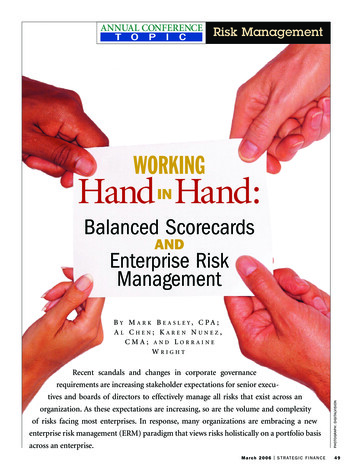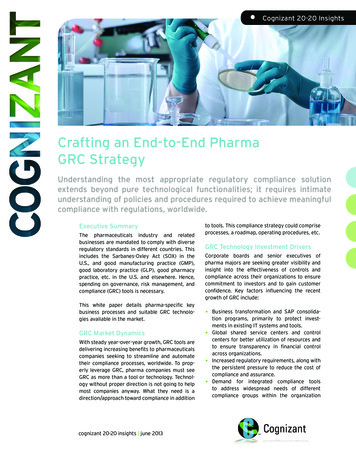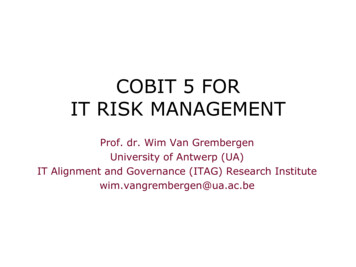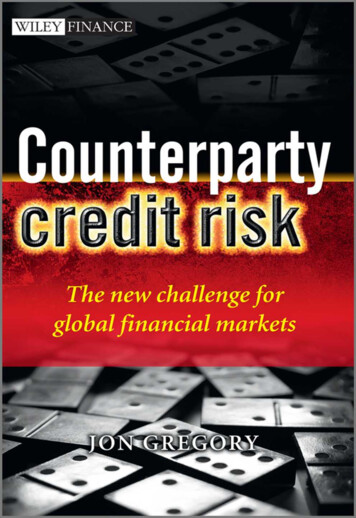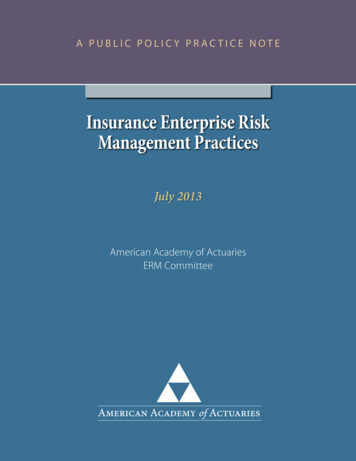
Transcription
A Public Policy Prac tice NoteInsurance Enterprise RiskManagement PracticesJuly 2013American Academy of ActuariesERM Committee
A PUBLIC POLICY PRACTICE NOTEInsurance Enterprise RiskManagement PracticesJuly 2013Developed by the ERM Committeeof the American Academy of ActuariesThe American Academy of Actuaries is a 17,000-member professional association whose missionis to serve the public and the U.S. actuarial profession. The Academy assists public policymakers onall levels by providing leadership, objective expertise, and actuarial advice on risk and financialsecurity issues. The Academy also sets qualification, practice, and professionalism standardsfor actuaries in the United States.
ERM PRACTICE NOTEThis Practice Note was prepared by the ERM Committee of the Risk Management and FinancialReporting Council of the American Academy of Actuaries. The Committee developed anoverview of the practices used by U.S. actuaries when performing or assessing the effectivenessof Enterprise Risk Management (ERM). While this Practice Note discusses some commonapproaches used in ERM, we make no representation of completeness; other approaches mayalso be in use.This practice note is not a promulgation of the Actuarial Standards Board, is not an actuarialstandard of practice, is not binding upon any actuary and is not a definitive statement as to whatconstitutes generally accepted practice in the area under discussion. Events occurring subsequentto this publication of the practice note may make the practices described in this practice noteirrelevant or obsolete.This practice note was prepared by the ERM Committee of the American Academy of Actuaries.Please address all communications to rmfrcpolicyanalyst@actuary.org.Participating Members from the 2011-2012 ERMCommitteeBruce Jones, ChairpersonMark BergstromMaryellen CogginsPatricia MatsonKevin MadiganMalgorzata JankowiakRoslanowskaMary Bahna-NolanAlistair MacphersonSeong-Min Eom1850 M Street N.W., Suite 300Washington, D.C. 20036-5805 2013 American Academy of Actuaries2www.actuary.org
ERM PRACTICE NOTETABLE OF CONTENTSI. Purpose/Introduction .4II. Role of the Actuary in ERM .6III. Concepts relevant to the practice and review of ERMA. Risk culture, risk organization, and risk governance . 6B. Policies and procedures . 8IV. Identifying and evaluating risks, setting strategy, and monitoring resultsA. Risk identification and categorization . 10B. Risk evaluation . 121. Economic Capital Models . 132. Model approach and key considerations . 143. Model assumptions and parameterization . 144. Risk Measures . 155. Using economic capital models . 156. Stress and scenario testing . 167. Controlling model risk environment . 178. Data collection and exposure monitoring . 19C. Risk Treatment1. Risk tolerance, risk limits, and risk appetite . 212. Consistency of risk appetite and financial planning . 223. Risk limits and authority guidelines . 224. Local risk limit protocols . 22D. Strategic Treatment of Risk1. Goals/Strategies. 232. Identifying strategic risk treatment options. 233. Evaluating strategic risk options . 234. Risk Mitigation. 24E. Risk Monitoring . 24F. External Impacts and Influences . 25V. Future Developments in ERM. 27Appendix 1: ERM definitions . 29Appendix 2: Relevant Actuarial Standards of Practice (ASOPs) . 31Reference Materials . 34 2013 American Academy of Actuaries3www.actuary.org
ERM PRACTICE NOTEI. Purpose and IntroductionThis Practice Note discusses Enterprise Risk Management (ERM) practices within insuranceorganizations1. According to the Casualty Actuarial Society, ERM is defined as “the disciplineby which an enterprise in any industry assesses, controls, exploits, finances, and monitors risksfrom all sources for the purpose of increasing the enterprise's short- and long-term value to itsstakeholders.” The Committee of Sponsoring Organizations (COSO) of the TreadwayCommission defines ERM as "a process, effected by an entity's board of directors, managementand other personnel, applied in strategy setting and across the enterprise, designed to identifypotential events that may affect the entity, and manage risks to be within its risk appetite, toprovide reasonable assurance regarding the achievement of entity objectives.” Both definitionsrecognize ERM as a corporate function that motivates an enterprise-wide understanding of riskand encourages commitment to the discipline of risk-based decision-making.The practice of ERM within the insurance industry continues to evolve. Those insurers that hadcommitted to the discipline of ERM several years ago have begun to realize tangible benefitsfrom their investment; many more insurance organizations continue to work to implement orenhance the discipline within their management framework. Meanwhile, interest in thesepractices continues to grow among rating agencies and regulators who are interested in howinsurers utilize ERM in the day-to-day management of their businesses and pursuit of their goals.Effective ERM is supported by a substantial amount of quantitative analysis. While certaintechnical risk measurement approaches are referenced within this Practice Note, a thoroughdiscussion of these approaches is outside the scope of this Practice Note. In addition, werecognize that the ERM practices of any given insurance organization may differ from thosediscussed within this Practice Note, since the practice of ERM and regulatory oversight of ERMcontinue to evolve.At the time of the writing of this Practice Note, the National Association of InsuranceCommissioners (NAIC) is developing regulatory requirements regarding an insurer’s Own Riskand Solvency Assessment (ORSA). In general, the regulatory requirements for an ORSAleverage the existing risk management processes used by an insurer, rather than create a separateand distinct process or set of reports. The ORSA would generally reflect the iterative process ofidentifying and evaluating risks, setting strategy, and monitoring results that an insurancecompany does as part of its overall ERM program. The information regarding this iterativeprocess can be helpful to insurers as they consider what type of information they will beproviding to regulators to meet the ORSA requirements. Other than a brief commentary onORSA in the section on external impacts and influences, this Practice Note does not describeORSA requirements separately given that regulatory reporting of an insurer's ORSA will likelyleverage existing ERM practices.Effective ERM relies on two primary goals: To identify, evaluate and, where possible, quantify risks and their correlations and/ordependencies from all sources across an organization; and To ensure that the organization actively implements risk treatment strategies that leverageknowledge of its risks to achieve appropriate risk and return tradeoffs in accordance withan organization’s values and goals.1 For the purpose of this practice note, “organization” is defined as an entity in the insurance industry for which ERM is being performed. 2013 American Academy of Actuaries4www.actuary.org
ERM PRACTICE NOTEWhile there are many ways to illustrate the ERM process, the following diagram highlights keyconcepts that insurance organizations have used to employ ERM frameworks. These conceptsinclude: A core risk culture, risk organization, and risk governance; An iterative process of identifying and evaluating risks, setting risk treatment strategies,and monitoring results, often called an ERM control cycle; and Recognition of the external impacts and influences of the economy, marketplace andviews of regulators, the investment community and rating agencies.This Practice Note seeks to treat each of these concepts in turn. It should be noted, however, thatsuccessful ERM frameworks provide for an integrated and iterative approach with a commitmentto continuous improvement. Attempts within this Practice Note to treat concepts sequentially arepurely for practical reasons and no inferences should be drawn from the order or segmentation.The iterative nature of the ERM process is fundamental to realizing its full value. In this note,insurance includes all types of products, (including reinsurance and co-insurance, for example).II. Role of the Actuary in ERMActuaries undergo extensive training and develop specialized experience in dealing withuncertainty within many areas of an insurance organization. Therefore, actuaries often play key 2013 American Academy of Actuaries5www.actuary.org
ERM PRACTICE NOTEroles in all aspects of the ERM control cycle. Chief Risk Officers (CROs) may be credentialedactuaries. This practice note provides a summary of the principal elements of an insurance ERMframework and is intended for actuaries who currently serve in an ERM role, are in the processof considering such a role or have been asked to perform an independent review of certainaspects of an ERM program.Throughout this practice note, references are made to practices by actuaries and practices byorganizations. Due to the evolving nature of ERM and the typical need for an individual ERMpractitioner to understand the overall ERM framework, these references regarding the ERMpractices of insurers is included to provide broader context to the readers of this practice note.While the intent of this practice note is to provide information to actuaries practicing in ERM,other professionals may find value in the note as well.III. Concepts relevant to the practice and review of ERMA. Risk culture, risk organization, and risk governanceEffective ERM is generally characterized by an enterprise culture that supports accountability inrisk-based decision making. Traits of organizations with an effective risk culture include anestablished risk governance framework, characterized by: broad risk management competency throughout the organization with a consensus thatrisk management is everyone’s responsibility; an informed board of directors; appropriate risk committees and subcommittees with clearly defined roles andresponsibilities; a CRO and/or ERM team with effective leadership and quantitative skills; effective risk management leaders undertaking coordinated efforts throughout thebusiness; and a common risk language in support of a consistent enterprise-wide view of risk.Such a governance structure provides an organization the platform necessary for theencouragement of effective dialogue among parts of the organization and among different levelsof leadership. Often, a governance structure will support executive commitment to theorganizational and infrastructure requirements needed to execute risk-based decisions. Practicalconsiderations including the size, complexity, risk profile, and strategies of an organization caninfluence roles and responsibilities of the ERM governance structure.Actuaries directly involved with ERM would typically develop a thorough understanding ofmanagement's and the board of director’s commitment to effective ERM; such a commitmentcould be revealed through a close inspection of an organization's risk governance program.Members of the governance structure overseeing an effective ERM program are typically strongadvocates of ERM and often convey a belief that ERM is a fundamental requirement for both thesurvival – and ultimately the success – of the organization. In organizations with effective ERMit is common for an executive at the highest level, such as Chief Executive Officer (CEO) orChief Financial Officer (CFO), to be a vigorous champion of ERM. Each member of thegovernance structure would typically have a clear understanding of their risk management rolesand responsibilities. 2013 American Academy of Actuaries6www.actuary.org
ERM PRACTICE NOTEThe CRO (or individual with CRO responsibilities) typically acts as a centralized coordinator ofrisk activities overseeing and facilitating business units' risk identification, risk evaluation and insome instances, risk treatment activities. It is most common for the CRO to report directly to theCEO, the CFO, the board of directors, and/or a sub-committee of the board.Actuaries practicing in ERM typically develop an understanding of the roles and responsibilitiesassigned to an organization’s CRO. A CRO's roles and responsibilities might include: Overseeing enterprise-wide risks, the management of those risks, and the enterprise’soverall risk profile; Facilitating the development of a formalized risk appetite statement and tolerance limits; Ensuring appropriate governance and controls are in place to manage and quantify risks; Achieving compliance with regulatory requirements imposed on the organization. Implementing a risk identification process throughout the organization. This includesensuring risk policies are in place around the roles and responsibilities of risk owners, theidentification, measurement and management of key risks and the escalation process forwhen risk tolerances are breached or near breach; Chairing the organization’s internal risk management committee (or similar managementfunction) and coordinating the reporting of key risks being managed within theorganization, including insurance, investment, liquidity and operational risks; Being one of the key authorities who manage significant risk events or crises; Working with management and risk owners to ensure key risks are assessed andquantified and to ensure key metrics for measuring risks are appropriate; Ensuring key risk assessments are considered in business and strategic planning in amanner consistent with the overall enterprise risk management framework; and Preparing a risk report or dashboard which monitors the key risks, measurement relativeto the defined risk appetite for the organization, and the impact of risk treatmentstrategies employed. The risk report is typically prepared and conveyed to the seniormanagement team, the risk management committee and the board of directors and/or itsrisk subcommittee(s) on a periodic basis.An ongoing challenge for a CRO when overseeing an ERM function is the “bringing together” ofthe various risk-related functions and specialists within the insurance organization under acommon framework and structure. Such risk-related functions may include: a businesscontinuity team; an internal audit function; a treasury function; a credit risk function; a capitalmanagement function; a market risk assessment function (which may reside within assetmanagement operations); an actuarial function; a reinsurance department or reinsurance buyingfunction; fraud and investigations experts; health and safety experts reporting to the humanresources (HR) function; and compliance teams in business units or in a central location.It may be impractical or inappropriate for an insurer to combine all risk functions within amanagement structure headed by a CRO. However, it is important that processes are establishedto ensure that risk functions act and are seen to be acting in a coordinated fashion and viewedthrough a common lens.The CRO might lead a corporate ERM team within which actuaries often play key roles. Thisteam may include a broad mix of capabilities and skills to support the delivery of ERMobjectives. Technical expertise alone might not be sufficient. The function may need projectand change management skills as well as broader relationship management skills. Major rolesand responsibilities of a corporate ERM team often include: 2013 American Academy of Actuaries7www.actuary.org
ERM PRACTICE NOTE Building, maintaining, and enhancing the ERM infrastructure;Building risk management buy-in;Ensuring consistency in the approach used for identification, quantification, treatment,and monitoring of risk;Acting as central clearing house for risk-based data and information;Supporting the business in the identification, assessment, and quantification of risks;Monitoring accumulations of exposure;Identifying and measuring - to the extent possible – correlations and/or dependenciesbetween risks;Preparing enterprise risk reports; andDeveloping and maintaining technical models that support the ERM function (e.g.,economic capital models, stress testing tools, etc.).Effective ERM typically relies upon oversight provided by the board of directors. Boards willoften approve the organization’s risk management policies and provide ongoing review of theorganization’s ERM practices including those relating to the identification and assessment ofrisks that could have a material impact on the organization– often referred to as “key risks.” Inaddition to approving an organization’s risk management policy, its board of directors couldperiodically review and discuss with management the following: Implementation, execution and performance of the organization’s ERM program; Any changes to the organization’s risk appetite due to new strategies or changes in thebusiness environment; Management of the organization’s most significant exposures (e.g., catastropheexposures, investment exposures, exposure to credit risk across investments andinsurance operations); The organization’s determination of appropriate risk mitigation strategies; Any material changes to the enterprise’s operations, including information technology; Any material changes to the legal and regulatory environments in which the enterpriseoperates; Strategic decisions that would alter the risk profile of the organization; Reports relating to material breaches of policy or limits; The organization’s business continuity and executive crisis management plans; and Any specific operational segments of the organization that could contribute unusual orsignificant risks that could have a material impact on the risk profile of the organization.The primary stakeholders of an insurance organization can include policyholders, investors,active and retired employees, management, creditors, and claimants. The potential view of riskand risk management objectives of different stakeholder groups are unlikely to be uniform andtherefore appropriate consideration needs to be given to conflicts of interest and the equitabletreatment of each group.B. Policies and proceduresA risk management policy (or policies) is a means by which an insurance organization describesits ERM framework, communicates risk management expectations and defines risk managementroles and responsibilities.A published set of enterprise risk management policies and procedures generally improves theeffectiveness of ERM. These are typically created and then reviewed and updated on a regular 2013 American Academy of Actuaries8www.actuary.org
ERM PRACTICE NOTEbasis with senior management, the board of directors, risk committees and business leaders.Effective risk governance typically involves a clear policy which includes accountability foradherence in fundamental areas, including: Well-defined risk preferences, risk appetite, risk tolerances and limits;Escalation procedures when the limits are approached or breached;Portfolio risk assessment of assets and liabilities and their inter-relationships;Effective assessment of results and feedback mechanismsRisk mitigation supported with cost benefit analysis;Communication by management of the risk responses and metrics for the organization;Risk and reward assessment of opportunities;Business continuity for the organization in the face of extreme events;Efficient and effective use of capital or other options in the reinsurance and capitalmarkets;Performance measurements based on risk adjusted returns; andManagement of and reaction to influences external to the organization.Controls and procedures integrated into ERM policy would typically include: Purpose and objectives, and how these tie into an organization’s strategy and risk profile; List of key activities, responsibilities, and accountabilities; Schedule identifying sequence and timing of tasks and milestones; Identification of key deliverables; Exception handling process; Change management process for modification and enhancements; Impact assessment to identify key assumptions and inputs; and Consistent reporting of key metrics used to monitor/mitigate/manage all key risks.One area of potential importance with respect to policy setting is risk-adjusted performancemanagement. Strategies are better executed when the interests of individuals and theorganization are aligned, and risk-adjusted performance metrics are one way that companiesintroduce such alignment. Some organizations have developed performance metrics based onrisk-adjusted metrics to facilitate comparison and evaluation of alternatives. The design ofappropriate risk-adjusted performance metrics that are practical and accepted by stakeholders canbe challenging. Policies designed to avoid conflicts of interest are frequently integrated intoprocesses and governance as appropriate to help address this challenge. 2013 American Academy of Actuaries9www.actuary.org
ERM COMMITTEE PRACTICE NOTEIV. Identifying & evaluating risks, setting strategy, and monitoring resultA. Risk identification and categorizationIn order to effectively manage risk it is important to first define and understand the risk to whichan insurance organization is exposed. The spectrum of risks considered should not be drivensolely by recent losses or by rating agency and regulatory considerations; it often includes abroader range of risks than might have been considered in the past and, critically, theinterrelationships among those risks under a range of economic, financial and marketplaceconditions. For an insurance organization, the sources of risk include the assets of theorganization, the liabilities generated from underwriting the insurance risks, and the strategiesand operations of the organization itself.It is also common for organizations to build a risk taxonomy as part of their ERM processes,which identifies the subrisks associated with each broad risk category, allowing for furtherclassification, and then management, of risks at a granular level.The following represent important characteristics of an insurance organization’s riskidentification process: Comprehensive—it covers all material and emerging risks. Inclusive—all risk-taking functions within the organization are involved in the riskidentification process. Efficient—any "bottom up" risk identification processes used should be balanced by "topdown" processes thereby limiting consideration of risks that pose little or no likelihood ofmaterial impact on the organization. Consistent—all risks identified are defined in the context of a common framework andconsider both the inherent risks to which an organization is exposed as well as the neteffect of mitigation strategies that may be in place (i.e., residual risk). Focused—there is a focus on qualitative and quantitative assessment (likelihood, impact,and speed of onset of risks) and prioritization of key risks.Enterprise-wide risk identification typically is performed on a routine basis or if the risk profileof the organization materially changes. Actuaries frequently are involved in this process. Aneffective method, adopted by many insurance organizations, for identifying enterprise-wide risksis to conduct periodic senior management risk workshops. The development and facilitation ofsuch workshops may involve the following considerations: Workshop participants—participants typically are those who are actively involved in risktaking or risk management functions and have a "stake in the game." Since theworkshops involve qualitative assessments of risk, participants typically possess a strongintuition about the most significant risks of the organization. Workshop participantsoften include: the CEO, general counsel, head of internal audit, CRO or equivalent, headof HR, heads of major business units, Chief Technology Officer (CTO), head ofmarketing, CFO, head of compliance, head of strategic planning, CIO, ChiefUnderwriting Officer (CUO), Chief Actuary, etc. 2013 American Academy of Actuaries10www.actuary.org
ERM COMMITTEE PRACTICE NOTE Advance communication—prior to the workshops, participants typically receive andreview material that prepares participants on the workshop objectives, includingbackground on the organization’s ERM program, a clear description of what is expectedfrom participants, definitions of risk categories, and an overview of the prioritizationframework (e.g., likelihood, impact, and speed-of-onset metrics).Risk registries, risk assessment surveys or interviews—risk registries and surveys orselected interviews may be provided or conducted in advance of the workshop toencourage a common risk language, motivate thinking, and establish an initial riskranking prior to the senior management workshop.Senior management workshop—attendees of the workshop typically review the rankings,discuss the highly-ranked risks and decide on how to delineate between key and non-keyrisks. The result of the workshop is usually a prioritized list of key risks that will bereviewed regularly and periodically updated in response to the organization’s changingrisk profile.ERM requires the introduction of efficient processes for the routine identification, assessment,mitigation and monitoring of the key risks to which the organization is exposed. For efficiency,ease of communication and to assist in the development of a common risk language, manyinsurance organizations aggregate these risks into several broad categories. For example: Insurance risk may include unexpected changes associated with non-investment relatedevents impacting the underlying insured population, such as mortality, morbidity,policyholder behavior, accident, catastrophe, and theft. Investment risk may include unexpected changes in external markets, asset prices,interest and exchange rates, credit spreads, and liquidity characteristics. Operational risk may include unexpected changes in elements related to operations, suchas human resources, technology, processes and controls. Strategic risk may include unexpected changes in key elements of strategy formulation orexecution.In addition to a process for the identification of known risks, the organization typically also hasin place a process to regularly identify and assess potential emerging risks. Environmentalscanning for emerging risks involves the collection and processing of information from multiplesources, for example: Attending industry conferences;Researching industry and academic journals;Serving on industry committees;Conducting discussions with industry experts;Conducting comparative analysis of risks disclosed by competitors; andUnderstanding general socio-economic and technological trendsReading ERM surveys and analyses.Coupled with the external environmental scan could be an introspective review of the exposures,claims, policyholder populations, terms and conditions of the policies written etc., to anticipateadditional sources of emerging risk. 2013 American Academy of Actuaries11www.actuary.org
ERM COMMITTEE PRACTICE NOTEB. Risk evaluationRisk evaluation typically follows the risk identification phase of the ERM cycle and may involvea wide range of methodologies and approaches. Actuaries have long been involved with riskevaluations, examining the potential impact of risk outcomes and the likelihood that these riskoutcomes might occur.Typical risk evaluation tools may be developed using a variety of methods for the quantificationof risk. Common risk quantification methods include: Stress Tests—Stress testing involves an assumption of a specific degree of adversity andmeasures the financial impact of that adverse experience upon the organization. Reverse Stress Tests – Reverse stress tests identify scenarios that cause insolvency andthen investigates their probability and possible mitigation. Stochastic Models—Stochastic modeling involves estimating probability distrib
Insurance Enterprise Risk Management Practices July 2013 Developed by the ERM Committee of the American Academy of Actuaries The American Academy of Actuaries is a 17,000-member professional association whose mission is to serve the public and the U.S. actuari
